Questar Distribution
![]() News
News ![]() Notes & Interesting Articles
Notes & Interesting Articles ![]() Overview
Overview ![]() Pricing
Pricing ![]() Products
Products ![]() Service or Repair
Service or Repair
Questar Telescopes ![]() LD Surveillance Systems
LD Surveillance Systems ![]() LD Microscopes
LD Microscopes ![]() Accessories
Accessories


QUESTAR DUPLEX TELESCOPE
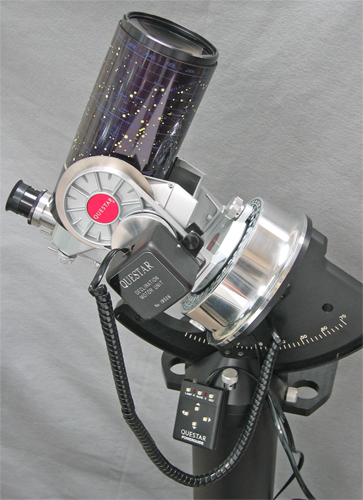 The Questar Duplex is an elegant high performance versatile telescope which combines the high technology optics, convenience, and great portability of the Questar Field Model with the fully instrumented features and tracking capabilities of the Questar astronomical Standard 3-½ telescope made since 1954. The Duplex resembles the Standard Questar 3-½ however, the 3 lb. (1.4 kg) Optical Tube of the Duplex is attached to the Questar Fork Mount in such a manner to facilitate the easy disjoining of optical tube from the mount. This provides the Duplex telescope will be even more versatile, a more compact and lightweight alternative to taking a complete fork mounted telescope into the field.
The Questar Duplex is an elegant high performance versatile telescope which combines the high technology optics, convenience, and great portability of the Questar Field Model with the fully instrumented features and tracking capabilities of the Questar astronomical Standard 3-½ telescope made since 1954. The Duplex resembles the Standard Questar 3-½ however, the 3 lb. (1.4 kg) Optical Tube of the Duplex is attached to the Questar Fork Mount in such a manner to facilitate the easy disjoining of optical tube from the mount. This provides the Duplex telescope will be even more versatile, a more compact and lightweight alternative to taking a complete fork mounted telescope into the field.
Right: Questar Duplex with Powerguide I controller, optional Motorized Declination Drive installed on the telescope Fork Mount, on a Questar Tristand (151,558 bytes).
Click image to see enlarged view (332,338 bytes).
As with most of the other Questar telescopes, the design and engineering features provided in the Questar Duplex made this telescope "user friendly" well before Jobs and Wozniak gave the world the "Macintosh" computer. Martin Cohen, founder of Company Seven proclaimed:
then a good case can be made that the Questar is the telescope for the rest of us"
The shift from one configuration to the other is accomplished by the use of a special fork mount Saddle which adds very little to the weight of the instrument but permits the quick detachment of the Optical Tube from the base of the Fork Mount with a single knurled bolt. No tools are needed to do this. The result is an instrument of unique flexibility, perfect for the multiple interests of a whole family of users.
The Duplex is the most versatile of all the Questar 3-½" telescopes, providing a portable spotting telescope or ultra telephoto lens (for use as the Field Model) without the need to carry the weight and bulk of a fork mount. The OTA of the Duplex is furnished with a machined aluminum base threaded to accept the common 1/4"-20 tpi, and 3/8" mounting bolts and so it is a simple matter to attach the OTA onto a variety of tripods, heads, or other fixturing hardware. In addition we provide a registration position to help insure the proper realignment of the telescope to the fork when it is reinstalled onto the Questar fork mount.
For those whose interests include astronomy, aside from being a complete working telescope, one could dismount the OTA from the folk mount and then employ the detached 3-½" OTA as a piggyback lens, or with its high effective focal length - a photo guide telescope, or the finder for a larger telescope (as on a nearby NASA 36" telescope!). Furthermore, this still offers the owner an extremely portable tracking telescope when the tube is "docked" into the fork mount.
Above left to right: illustrating the removal of Questar Duplex telescope optical tube assembly from its fork mount. Instrument shown:
Image shows the Questar Control Box on a Standard 3-½ telescope. Aside from the shorter Dewcap to accommodate the Rotating Collar of the Duplex this is otherwise similar to the Duplex.
Click on image to see enlarged view (232,764 bytes)
The Questar Duplex telescope incorporates the Questar Control Box which is engineered and refined to provide reliable convenience and safety features. This housing at the rear of the telescope provides two viewing or imaging ports (at top or axial), with control levers and linkages providing quick flick knob selection. This arrangement provides three magnification (power) changes per eyepiece:
2. Low Magnification at Prime Focus. Magnification = 1280 divided by focal length of eyepiece
3. High Magnification. Provides about 2X magnification when observing through the telescope; not use able with the Finder.
So, for example one could use the 24mm Brandon eyepiece at 4X with the Finder, then select 50X through the telescope, then increase the magnification to 80X or more by dialing in the Barlow*. Observing through the any of the three magnifications can be achieved and changed without the observer ever moving away from the eyepiece!
The provided telescope Barlow is approximately 2X, but we have seen a range over the years of from 1.6 to more than 2X. Company Seven's testing process measures it exactly, and we provide the information to our customers so that they may make better choices of eyepieces.
A focusing eyepiece holder (Diopter Adapter) at the top of the Control Box permits the user to set the diopter adjustment to focus of the Finder for most persons.
Features within the Questar Control Box include a zenith prism diagonal that can be dialed in or out by the selector knob to move the light from either Finder or Telescope View up to the eyepiece. The eyepiece is installed at a right angle to the barrel thereby making the observing of objects overhead more comfortable. To help place the eyepiece at a more comfortable position for the observer, particularly when tracking in a pole aligned mode, the entire optical tube assembly can be rotated within the fork mount by about 30 degrees clockwise to the right or 30 degrees counterclockwise to the left. To rotate the barrel simply grasp the fork mount with one hand to steady the set, then with the other hand grasp the Control Box to rotate the optical tube. The limit at of rotation is mechanical as the eyepiece holder will be restricted at the length of travel the the stainless steel fin atop either fork tine. Before rotating the barrel insure the eyepiece holder diopter is not dialed down (clockwise) so far that it is binding agains the black anodized aluminum retaining ring at the rear of the Duplex optical tube barrel, otherwise you may mar this.
The telescope set includes an off-axis glass Solar Filter for the telescope objective (a full aperture filter is an optional upgrade) providing a pleasing orange red Sun with fine details including Sunspots and Faculae. The Control Box incorporates a solar filter for finder lens to facilitate finding and centering the Sun in the field of view of the telescope and to prevent the accidental observing of the Sun through an unfiltered Finder.
The barrel of the telescope is silk screened with a functional Moon Map, while the removable slide on Dew Cap incorporates a functional Star Chart.
The equatorial fork mount is made of a brushed cast aluminum which is lacquer painted. Each of both axes has a manual friction drive control, the Right Ascension also having slip clutch permitting manual override of the tracking motor. The mount includes an AC powered synchronous clock drive motor (world wide portable 9 volt drive corrector optional), driven Right Ascension setting circle, and a Declination circle with declination motion variable clutch lock. The drive is smooth enough to provide flawless tracking of celestial objects for visual applications, although the telescope can easily be accessorized to introduce one into most types of film or CCD astrophotography.
The Questar Duplex telescope stores into a furnished compact carrying Vinyl Clad Carrying Case (easily "carry on luggage") that has pockets sewn in the liner to accommodate the included table-top tripod legs, an extra eyepiece, the solar filter, and AC adapter cord. There is also a pocket for the optional Powerguide Controller for worldwide 9 volt D.C. battery powered operation.
When you wish to use your Questar 3-½ astronomical telescope in the backyard or at a location with no convenient platform to set up the provided table-top tripod, we recommend you consider a third party good quality rigid field tripod. Or for even better convenience, consider our Questar Tristand. The Tristand is refined, compact telescope equatorial platform and pier which places the Questar 3-½ eyepiece at a comfortable 41" height. A taller Astropier is also available. The Astropier and Tristand are suitable for use in latitudes from 26 to 90 degrees, or 4 degrees with the optional Wedge.
For more information about how to work your way through the decision making process of choosing and specifying a Questar 3-½" telescope, the common accessories, and desirable options please feel free to call us, send an Email inquiry, visit our showroom, or refer to the article in our Questar Notes/Library section "How to Choose a Questar Astronomical Telescope.".
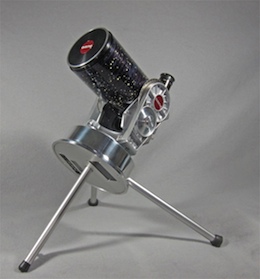
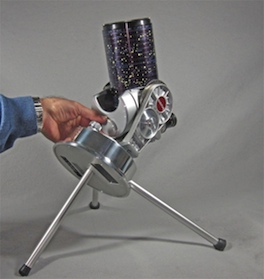
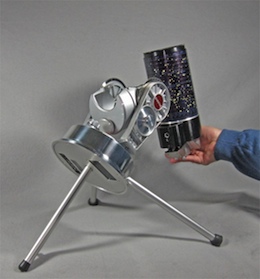
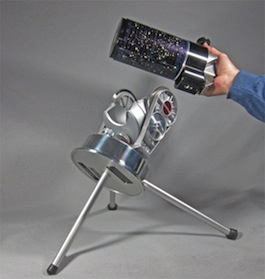
1. atop its tabletop tripod, 2. tilted to access the OTA restraining bolt, 3. loosening the bolt to free the OTA, 4. the OTA shown clear of the saddle and fork mount.
Each image size Approx. 26 kbytes. Click on each image to see enlarged view (each Approx. 123 kbytes).
 Left: Questar Control Box (showing from top to bottom): 1. Questar Brandon Eyepiece in Diopter Adjuster - to focus Finder (with two locking set screws), 2. Barlow Control lever - doubles the magnification when rotated into place (clockwise from 10 to 12 o'clock), 3. Finder or telescope view selector knob (rotate clockwise from 12 to 3 o'clock into "Finder" position or reverse for telescope view), 4. Axial Port - accepts options including Camera Coupling Set or Image Erecting Prism, 5. Focus Control Knob - jewel smooth, 6. Solar Filter for Finder Mirror (knob below and left of Focus knob) dialed clockwise to store Filter. The Dew Shield/Lens Shade with functional Star Chart is visible just ahead of the Control Box.
Left: Questar Control Box (showing from top to bottom): 1. Questar Brandon Eyepiece in Diopter Adjuster - to focus Finder (with two locking set screws), 2. Barlow Control lever - doubles the magnification when rotated into place (clockwise from 10 to 12 o'clock), 3. Finder or telescope view selector knob (rotate clockwise from 12 to 3 o'clock into "Finder" position or reverse for telescope view), 4. Axial Port - accepts options including Camera Coupling Set or Image Erecting Prism, 5. Focus Control Knob - jewel smooth, 6. Solar Filter for Finder Mirror (knob below and left of Focus knob) dialed clockwise to store Filter. The Dew Shield/Lens Shade with functional Star Chart is visible just ahead of the Control Box.
1. Internal Finder of 100mm EFL. Magnification = 100 divided by focal length of eyepiece
Contents Copyright 1994-2004 Company Seven - All Rights Reserved

